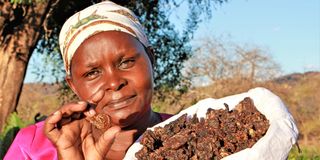Dryland tree spawns gum, resin trade

Rachael Katethya displays resin obtained from the tree called Commiphora baluensis in Kitui County. Resin trade has enabled her to educate her children with ease and build a permanent house.
What you need to know:
- Residents of Makueni harvest resin from a tree known as Commiphora baluensis, which they sell to agents who export it for use in making high-end perfumes, food flavours and medicine in a business that is offering reprieve to many especially during the dry season.
- Whereas resins are produced by comiphora tree varieties, gum is produced by the acacias. The gum is also highly sought-after in the global market, where it goes for Sh2,000 a kilo.
- However, for Kitui residents, Itula’s highest value is in its kithena, which is used in making high-end perfumes, food flavours and medicines.
- Gum and resin should be used shortly after harvesting so that they do not lose their value.
Armed with a small basket and a knife, Rachael Katethya, a resident of Mbitini in Kitui County, stands next to a tall tree that resembles an acacia.
She then uses the knife to gently scrub sections of the bark of the tree. This brings out a golden brown substance that she puts in her basket.
Rachael is harvesting resin from the tree that is scientifically known as Commiphora baluensis. Locals call it Itula.
“This is our new source of income,” says Rachael as she places the resin, locally known as Kithena, in the basket, working hard to fill it. She also ensures it is clean, as the product ends up in the international market.
Resin, a sticky substance produced by trees, is highly sought-after by exporters, who camp in the arid area, buying it from harvesters like Rachael.
Whereas resins are produced by comiphora tree varieties, gum is produced by the acacias. The gum is also highly sought-after in the global market, where it goes for Sh2,000 a kilo.
Highest value
The Itula tree is characterised by translucent flakes peeling from its bluish trunk and the main branches. It thrives in dry lowlands.
Besides Kitui, it is also found in Kajiado and Makueni counties, where it is a major source of high-quality timber and poles, which are resistant to termites.
The trunk, which grows up to 35cm in diameter, is also used for making traditional beehives.
However, for Kitui residents, Itula’s highest value is in its kithena, which is used in making high-end perfumes, food flavours and medicines.
“Many of us turn to itula when the farms are not productive during the dry season. We started the business two years ago after buyers started to flock the area,” Rachael tells Seeds of Gold.
The harvesters normally make incisions on the trunks, from where the resin comes out. They then allow it to dry.
Besides harvesting the produce, Rachael, one of the big traders in the product, also buys it from her neighbours in Kisayani village.
Contracted several youths
“I have contracted several youths who harvest it for me. When they bring it here, I check its quality, ensuring it is not adulterated with soil and other low-quality materials as some harvesters try to earn more by increasing its weight,” she says.
She then sorts the product that is delivered at her homestead in grades and buys a kilo at Sh250. Later, she sells a kilo for up to Sh500 to agents of exporters who ship the commodity to China and Europe, where it is processed into high-end products.
Kisangau Kyule, a resident of Mutha on the border of Kitui and Tana River counties and a resin harvester, says they seek permission from owners of the land where the trees are found.
“Some demand a little fee of Sh100 per tree. Harvesting the gum is a daunting task that involves traversing expansive regions looking for injured trees. Many players come on board when learners are on holiday,” he says.
The young man sells at least 10kg of kithena per week to Adhan Ibrahim, who runs a bulking shop at Mutha township. The businessman has been dealing in the commodity since 2018 after a friend introduced him to the trade.
“The economic slump caused by Covid-19 has slowed down the export of kithena. This has in turn seen the prices we offer drop to Sh300 per kilo from over Sh500,” said Ibrahim.

Prof Albert Luvanda, head of the Kenya Forestry Research Institute’s arid lands station in Kitui, holds cans containing resin and gum. He advises that gum and resin should be used shortly after harvesting so that they do not lose their value.
Abdullahi Noor Abdi, another export agent who runs aggregation centres in Mutomo and Mutha townships, buys the commodity at between Sh300 and Sh700 depending on the market forces. It fetches the highest price when it rains.
Two harvesting seasons
“Itula is part of a family of thorny trees that produce gums and resins of high commercial value,” says Albert Luvanda, head of the Kenya Forestry Research Institute’s arid lands station based in Kitui, whose PhD thesis at Kenyatta University was based on the gum and resins value chain in the country.
“The resin appears naturally on the injured parts of the trees. The harvesters also tap the backs to induce its production.
Gum and resin should be used shortly after harvesting so that they do not lose their value,” Prof Luvanda tells the Seeds of Gold.
The yield depends on the rains, the type of soil, the size of the tree and the number of wounds on the tree, he adds.
“On average, a tree yields 2kg of gum or resin per year. A year consists of two harvesting seasons. Over-tapping should be avoided as this exposes the trees to harsh weather conditions, pathogens and diseases.”
Trading in gum and resin goes back to time immemorial. Two acclaimed products of gum and resin – myrrh and frankincense – were part of the gifts the three wise men delivered to baby Jesus as recorded in the Bible.
According to Kefri, Kenya is the third-largest exporter of gum and resin after Ethiopia and Somalia.
Value addition
Ford Foundation, an American development organisation, introduced the business in the drylands in the 1990s.
The trade is vibrant in Wajir, Mandera and Isiolo counties where Acacia senegal, Acacia seyal, Boswella neglecta, Commiphora myrra and Commiphora holtiziana, close relatives of itula, thrive.
Rachael has a lot to show for the four years she has been dealing in kithena. A widow, she started small and has risen to the league of the big players in the industry.
The trade has enabled her to educate her children with ease and build a permanent house.
Prof Luvanda, who studied the impact of the gum and resin enterprise in Wajir County, regrets that the potential of the value chain remains largely unexploited in the country.
“The resin and gum are mainly exported in their raw form, yet with value addition, and harvesting communities coming together through cooperatives, they can earn more. Still, there are leakages across the country’s porous borders where it is smuggled," he says.
****
Difference
1.Resin is produced by comiphora tree varieties while gum comes from acacia varieties. Gum is soluble in water. Resins is not. Gum Arabic is produced by Acacia senegal and Acacia seyal trees found mainly in northern Kenya.
2.Both gum and resin produce the raw materials for high-end products.
3.Before the discovery of the industrial use of the resin, the sap was widely believed to be medicinal especially in Kitui County. Herbalists treat septic wounds by applying the resin. In some sections, chewing the product is widely believed to cure fever. The most highly guarded use of the sap, however, is in curing assorted sexually transmitted infections





